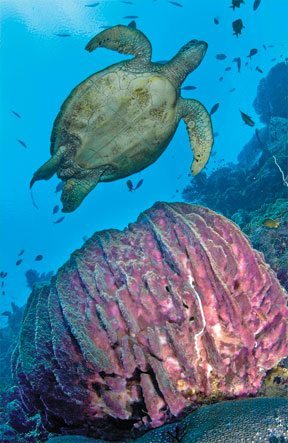Sea turtles make wonderful subjects. While some turtles are wary of divers, many allow a close approach as long as you move slowly and don’t frighten your potential photo subjects. The key is to move slowly. Never chase.

Photo by Marty Snyderman
It’s relatively easy to photograph a turtle that is swimming in open water. In this scenario you don’t have to be concerned with the turtle “getting lost” in the background by blending with an object of similar color and brightness.
But even with a cooperative turtle, creating a compelling shot that places the animal in the context of a colorful reef environment can be challenging. When there is reef behind the turtle, no matter how close or far away the reef, darkly hued turtles routinely blend into the background, leading to disappointing outcomes.
You can try getting very close to the turtle to help the light from your strobe “pull” the turtle out of the background, thus making the animal stand out in the shot. But with this technique it is difficult to add an appealing splash of color from the reef. And there isn’t much to be gained by adding boring-looking reef to the photograph.
Another way to overcome the problem is to compose your frame with a colorful element such as a sponge or sea fan in the immediate foreground with the turtle a little farther away. Adding a splash of color in the foreground by lighting the foreground subject with your strobe can add an appealing dimension to your photograph.
For best results, position yourself so you can compose a scene with (1) a potentially colorful subject in the foreground so you can light that element with your strobe, and (2) with the turtle swimming against a background of inviting blue-to-green water, not reef. You will probably want to be looking slightly upward at the turtle when composing your shot.
The key to success is to properly expose the colorful foreground element with your strobe and to have the turtle prominently positioned against a background of water that is properly exposed and that looks inviting. Start this process by taking a light meter reading on the water in the background where you think the turtle will be. The light meter reading will establish your f-stop and ISO. Knowing those factors enables you to set your strobe power so you can properly expose the foreground subject while composing a pleasing shot.
If you need to get closer to your colorful foreground subject to compose a pleasing frame, turn your strobe power down. Don’t close down your aperture because that will darken the background water. Conversely, if you need to get farther away from your foreground subject to compose a pleasing shot, increase your strobe power. Don’t open up your aperture because that will lighten the background water.



